Versatility And Technical Advantages Of Palm Oil
Malaysian Palm Oil Promotion Council MPOPC
http://www.mpopc.org.my
Several important technical properties and other benefits of palm oil can be described under the following headings:
- High stability to oxidation
- Natural solids content
- Stability in the beta prime crystalline form
- Ready and increasing availability world-wide
- Competitive Price And Cost Effectiveness
- Nutritional Attributes Of Palm Oil
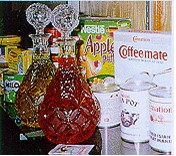
High Stability To Oxidation
Oils and fats generally are susceptible to attack by atmospheric oxygen, resulting in rancid flavours and rejection by the consumer. Palm oil contains a high level of the tocols (Vitamin E) which are powerful natural antioxidants. It contains a very low concentration of linolenic acid and only a moderate proportion of linoleic acid, the most readily oxidized components of oils. Therefore, it has exceptional resistance to rancidity. It is universally recognized as an excellent frying oil for large-scale food manufacture - in restaurants and at home.
Palm oil is known for its excellent stability at high temperatures. The low content of polyunsaturated fatty acids, which confers resistance to rancidity, also makes it less prone to oxidative polymerization. The formation of polymeric materials is responsible for the increase in viscosity and for the foaming tendency of a heated oil.
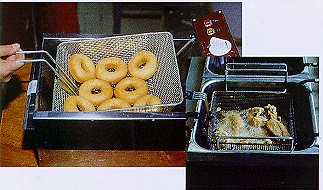
Palm oil, with its moderate content of linoleic acid and high level of natural antioxidants, is highly desirable and suitable as a deep-frying medium. It also helps to extend the shelf-life of foods in which it is used. Since palm
oil neither polymerizes readily nor foams excessively, as most unsaturated oils do, it can be re-used more often than these oils. Accordingly, palm oil is being increasingly used in restaurants, fast food outlets, snack food manufacturing and in the home. Palm olein, the liquid fraction of palm oil, is also stable to oxidation and, in semi-tropical and tropical countries, remains clear on the shelf. Palm olein may be fractionated a second time, or blended with other vegetable oils such as soyabean, sunflowerseed, rapeseed or cottonseed, to avoid clouding or solidification in colder climates. Palm olein improves the frying properties of blends and extends their shelf life and that of the foods fried in them.
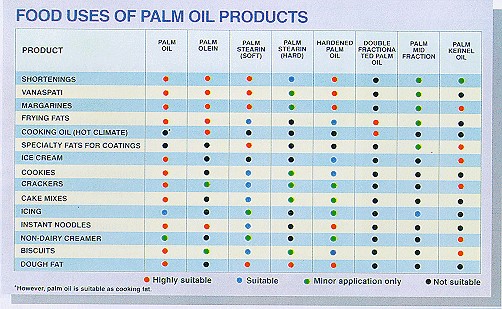
Natural Solids Content
Many popular food products require fat with a solids content, e.g. table and industrial margarines, low fat spreads, cake shortenings and confectionery fats. This requirement may be met either with a hydrogenated liquid oil or by
using the natural solids content of palm oil and palm stearin. Both palm oil and palm stearin can be used either by blending or by interesterification with other oils to create any desired solids content profile. The use of palm oil to provide solids is more economical than hydrogenation of liquid oils, particularly in locations where electricity is expensive. Also, it avoids the introduction of trans fatty acids into end products.
Stability In The Beta Prime Crystalline Form
Countries that are major producers of vegetable oils naturally attempt to use their own resources. In Canada, for example, margarines and shortenings are mainly made from locally grown and processed canola oil after hydrogenation. However, the products develop a coarse granular structure, an unattractive appearance and
poor performance in baking.
This is because the solid components of the blend have developed large crystals of the beta form. However, the addition of palm oil at 15 - 20% of such a blend induces beta prime crystal formation and improves the function and appearance of the product. Similar applications are also useful in products based on sunflower and soyabean oils.
Ready And Increasing Availability World-Wide
Before choosing an oil for use in their products, food manufacturers naturally need to be assured that the supply will be reliable. In fact, palm oil has an edge over other vegetable oils in regard to reliability of supply for the following reasons:
- The oil palm starts to bear fruit three years after planting and has an economic life span of 25 years. Its continuous production of fruit throughout the year is a major advantage over annual oil crops, which permits very efficient utilization of labour and of equipment for harvesting and oil extraction. Moreover, the fruit is processed within hours of harvesting, so that crop storage facilities are not required. The perennial oil palm is the Most productive oil crop. Its annual yield of some 3.5 - 5 tonnes of crude palm oil per hectare in Malaysia makes it about ten times as productive as other oil crops (see Chart).
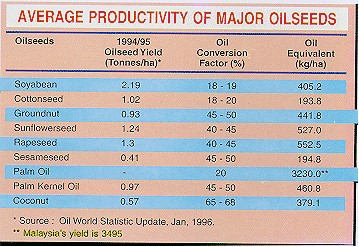
- Planting of oil palm in Malaysia is mainly undertaken by big estate companies. This assures better utilization of resources as well as application of advanced management systems and planting techniques, which all help to raise the overall yields.
- The production of palm oil has shown a faster rate of growth than all other oils and fats during the period 1980 -1995 (see Chart below), and there is potential for further growth, whereas the production of many other oils and fats has actually stagnated or declined. So on this ground as well, the future supply of palm oil is assured. Malaysia does not experience natural disasters such as earthquakes, typhoons or serious floods. The country's political stability coupled with continued strong support from the Government have enabled the palm oil industry to develop and implement long-term plans for increased production.
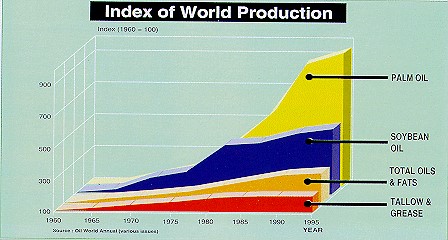
Competitive Price And Cost Effectiveness
The price of palm oil has been consistently lower than that of other vegetable oils, so that palm oil products are more economical than other vegetable oils such as soyabean oil and cottonseed oil (see Chart below). Palm oil can replace other oils and fats for many uses.
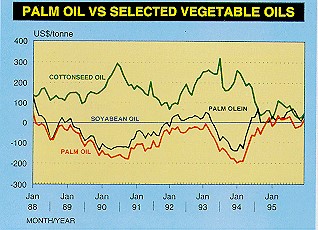
By contrast with fully liquid oils, palm oil does not usually need hydrogenation, a process which raises costs by as much as 30 per cent. The Chart below illustrates the cost savings obtained by using palm oil in place of other major vegetable oils.
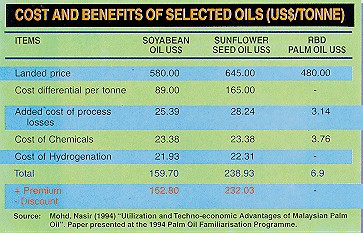
About 10% of the world's palm oil goes into non-edible applications. Soap manufacture is a major use for fats, and traditionally the main ingredients have been coconut oil and tallow. Palm kernel oil, palm oil and palm stearin are suitable alternatives for these. With the present relationships of price and availability, they are increasingly being preferred to the traditional materials.
Waste materials from the palm oil industry are also being converted into value-added by-products. By means of appropriate technology, palm trunks and fronds, empty fruit bunches, and kernel shells and kernel meal can all be utilized. For instance, empty bunches can be used as fuel for mill operations, while kernel shells, besides being valuable fuel, can also be utilized for road surfacing.Recent developments have led to palm oil becoming a major raw material for oleochemicals in applications such as cosmetics and detergents and other surface active products, while palm kernel oil is a suitable alternative to coconut oil in many oleochemical applications.
Nutritional Attributes Of Palm Oil
Since palm oil is used worldwide in food, its nutritional properties are naturally of great interest to the consumers. This aspects has been the object of research by internationally respected nutritionists who established the following facts:
- Having a naturally moderate to high level of saturation, palm oil does not require hydrogenation for use as fat component in foods and, as such, doest not contain trans fatty acids.
- Like other common edible fats and oils, palm oil is easily digested, absorbed and utilized in normal metabolic process.
- Red (unprocessed) and red or golden (specially refined) palm oils, are the richest sources of beta-carotene, an antioxidant, and precursor of Vitamin A and tocotrienols, all of which have antioxidant properties.
These results have been published in full or in part in international scientific journals and have been reviewed and endorsed by committees of leading nutrition scientists.

Source: MPOPC
